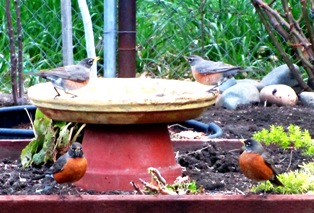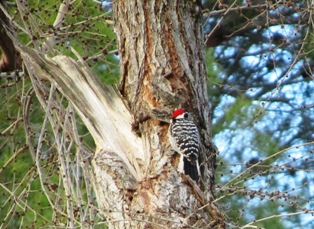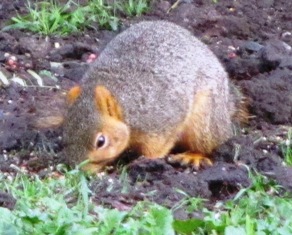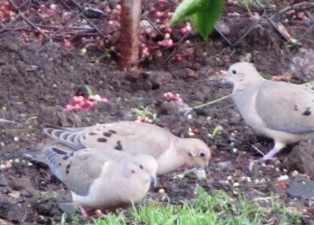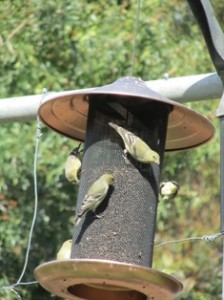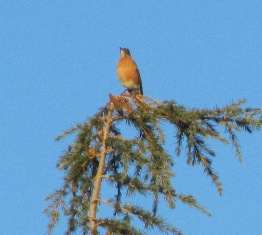Springtime Serenades from the Garden
The robins have arrived on the farmette. I’ve been moving dirt with the help of my husband and a worker and there are worms galore. If there’s anything a robin delights in more than dining on a fat, pink worm it surely is singing.
Throughout the morning, I hear its song–cheerily cheerily cheerily as it throws back its head and stands at attention in its red vest and gray-colored waistcoat.
The robin is one reason why I don’t believe in using insecticides for trees and lawns. Rains wash these contaminants into the soil, the earthworms eat the contaminated dirt, and the robins eat the worms. The cycle can be fatal for the birds.
High in an old elm tree with broken limbs and rot in places, a Nuttall’s Woodpecker adds its course drill of pr-r-r-r-rip to the robin’s song. What the woodpecker lacks in beautiful song, it more than makes up in its appearance. This fellow has a black-and-white striped face and back and a bar of black around its eye. Its cap is a vibrant splash of red.
These birds dine on insects from tree bark and frequently build their nests in a dead limb. Their clutch of white eggs hatch in about 14 days and the male shares responsibility with the female in incubating the eggs.
So while the work of moving dirt (so far, digging down to the septic to inspect and reinforce it and moving a section of dirt to the garden to replace an old gravel driveway) is tedious and time-consuming, the serenades of birds in the garden make the effort a bit more tolerable.
Serve Up Seeds for Furry and Feathered Creatures
Squirrels can contort their bodies into bizarre and exotic positions just to get at the seeds in a bird feeder, as any wildlife watcher can tell you. But they aren’t crazy about all birdseed. Safflower is a good example of a seed loved by birds but not squirrels. The squirrels will forgo a whole feeder of that seed in order to dine on sunflower hearts that is also a favorite of chickadees, finches, and woodpeckers. Pesky squirrels will also paw through a bird feeder to eat other seeds mixed into a commercial wild bird feed but still pass on eating the safflower if it is present.
Since both squirrels and many species of wild birds love sunflower seeds, we grow several types throughout the summer. When fall approaches, we place the dried heads of the sunflowers in an area away from a bird feeder to attract the squirrels and hopefully limit their foraging of food intended for the feathered wildlife. Sometimes it works. However, mourning doves are ground feeders and so are quail. We’ve found the squirrels and the birds foraging together for sunflower seeds.
A squirrel and mourning dove share a meal
The finches enjoy the black Nyger (or thistle) seeds so we keep one feeder of that seed just for them. We love the splashes of yellow (the coloring of their breasts) as they flit around and perch on the feeder to devour their favorite meal. But other birds with small bills like the California quail, pine siskins, towhees, dark-eyed juncos, song sparrows, and purple finches also are attracted by Nyger seeds and will dine often if the feeders are kept filled.
Squirrels and some types of birds particularly enjoy pumpkin seeds and peanuts, so we also put those out when the weather becomes bleak and we’re pretty certain that the wildlife around us isn’t finding much food. During those periods, we also hang suet for the birds, especially those that hang around for the winter but don’t have a lot of food choices such as crows, robins, and the American goldfinches.
When you ensure adequate food supply for the furry and feathered creatures in your backyard, you will be rewarded with many entertaining and heart-warming images. Keep your camera handy for capturing squirrel contortions or surprising pictures of who dines with whom.
Backyard Bird Watching Soothes the Spirit
Back in my old neighborhood I spent many happy hours watching the birds that flew into the massive pines behind my San Jose home. Then when I moved to the Miami area, I felt thrilled to spot a long-legged, white egret, a small but determined sandpiper, or a bald eagle or two visiting my home on the lake. The visits of those exquisite creatures were always brief and all too soon they would fly back to their nests in the brush or tall pines of the Florida Everglades, only a mile or two away. Now here on the Henny Penny Farmette, I am serenaded every morning by songbirds, often sweet little yellow finches feeding at the feeder five feet above the fence at the back of the property.
If you feed them, they will come. Finches love the black nyger seed. Our local feed store sells the seed in bulk and also in white mesh sacks with tiny holes perfect for finch beaks, which are quite small. Of course, some seeds will drop to the ground and, in my experience, easily sprouts and grows into a tall, skinny plant with a blue bloom. I’ve heard that you can sterilize birdseed so it would not root and grow if you toast the seeds for a short time in the oven on high heat. But be careful not to burn them. Not even birds like burnt food.
While making coffee this morning, I peered out the kitchen widow to see a beautiful bird with a rust colored breast perched atop the fifty foot pine. I believe it was a robin. Grabbing my camera, I got off a couple of shots before the bird took flight. I’m pretty sure I haven’t seen the last of that bird. Rain is coming again in a few days and robins love to hop around searching for worms. So regardless of what neighborhood I’m living in, I create habitat and put out food for the wild birds. It welcomes them and their presence nurtures my spirit.
 Facebook
Facebook Goodreads
Goodreads LinkedIn
LinkedIn Meera Lester
Meera Lester Twitter
Twitter






